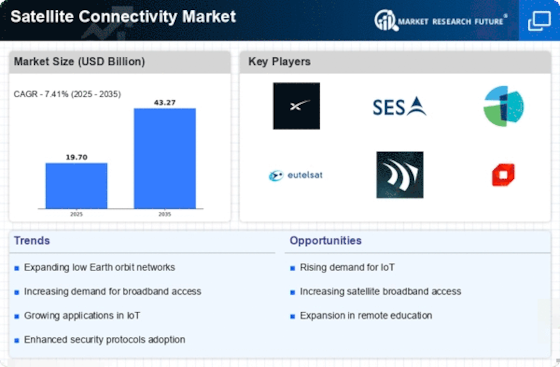Expansion of IoT Applications
The proliferation of Internet of Things (IoT) devices is a key driver for the Satellite Connectivity Market. As industries increasingly adopt IoT solutions for monitoring and automation, the need for reliable satellite connectivity becomes paramount. Data suggests that the number of connected IoT devices is expected to reach over 30 billion by 2025, creating a substantial demand for satellite communication services. This growth is particularly evident in sectors such as agriculture, logistics, and smart cities, where satellite connectivity enables real-time data transmission and operational efficiency. Consequently, the Satellite Connectivity Market is likely to benefit from this trend, as it supports the infrastructure necessary for widespread IoT deployment.
Advancements in Satellite Technology
Technological advancements in satellite systems are propelling the Satellite Connectivity Market forward. Innovations such as high-throughput satellites (HTS) and low Earth orbit (LEO) satellites are enhancing the capacity and efficiency of satellite communications. These advancements allow for greater bandwidth and lower latency, making satellite services more competitive with terrestrial options. Recent developments indicate that the deployment of LEO satellites could reduce latency to as low as 20 milliseconds, which is comparable to traditional broadband services. As these technologies continue to evolve, the Satellite Connectivity Market is likely to see increased adoption and investment, further driving growth.
Government Initiatives and Investments
Government initiatives aimed at enhancing digital infrastructure are significantly influencing the Satellite Connectivity Market. Various countries are investing in satellite technology to improve connectivity in rural and remote areas. For instance, initiatives such as the Universal Service Fund in several nations aim to provide internet access to underserved populations. These investments not only promote economic growth but also enhance social inclusion by ensuring that all citizens have access to essential services. The Satellite Connectivity Market stands to gain from these governmental efforts, as they create a favorable environment for satellite service providers to expand their reach and improve service offerings.
Increased Demand for High-Speed Internet
The Satellite Connectivity Market is experiencing a surge in demand for high-speed internet services, particularly in remote and underserved regions. As more individuals and businesses seek reliable internet access, satellite technology offers a viable solution. According to recent data, the number of satellite internet subscribers has increased significantly, with projections indicating a potential growth rate of over 20% annually. This trend is driven by the need for seamless connectivity in various sectors, including education, healthcare, and telecommuting. The Satellite Connectivity Market is thus positioned to capitalize on this growing demand, as it provides essential infrastructure to bridge the digital divide and enhance global communication.
Rising Demand for Disaster Recovery Solutions
The Satellite Connectivity Market is increasingly recognized for its role in disaster recovery and emergency response. In times of natural disasters, traditional communication infrastructure often fails, highlighting the need for reliable satellite connectivity. Data indicates that satellite communication systems are crucial for coordinating rescue efforts and providing essential services during emergencies. As awareness of this capability grows, organizations and governments are investing in satellite solutions to ensure continuity of operations in crisis situations. This trend not only underscores the importance of satellite connectivity but also positions the Satellite Connectivity Market as a vital component of disaster preparedness and response strategies.


















Leave a Comment